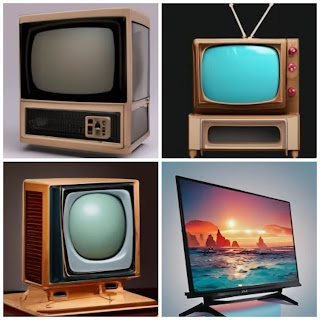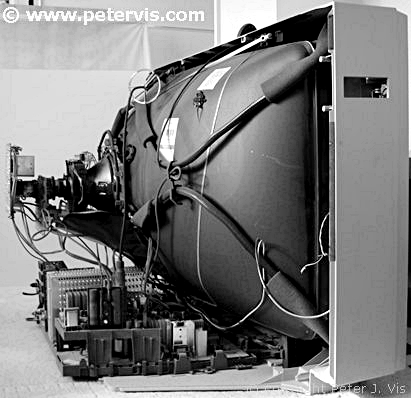From Cathode Rays to Streaming Wars: A Journey Via Tv’s A long time
Associated Articles: From Cathode Rays to Streaming Wars: A Journey Via Tv’s A long time
Introduction
With enthusiasm, let’s navigate by the intriguing matter associated to From Cathode Rays to Streaming Wars: A Journey Via Tv’s A long time. Let’s weave attention-grabbing data and supply recent views to the readers.
Desk of Content material
From Cathode Rays to Streaming Wars: A Journey Via Tv’s A long time

Tv. The flickering field that has captivated generations, formed cultures, and redefined leisure. Its evolution, from a cumbersome novelty to a ubiquitous, interconnected display screen, is a captivating reflection of technological development and societal change. This journey by tv’s a long time reveals not solely its technological transformation but additionally its profound impression on our lives.
The Pioneer Years (Nineteen Twenties-Fifties): A Black and White World Takes Form
The seeds of tv have been sown within the early twentieth century, with pioneers like Philo Farnsworth and Vladimir Zworykin laying the groundwork for digital tv. The Nineteen Twenties and 30s witnessed experimental broadcasts, however the Second World Battle delayed widespread adoption. The post-war increase, nonetheless, fueled a speedy growth. The Fifties noticed tv explode into the American front room, reworking household life and leisure.
These early units have been cumbersome, costly, and displayed photographs in black and white. Programming was restricted, largely consisting of dwell broadcasts, selection reveals, newsreels, and early sitcoms like "I Love Lucy," which turned a cultural phenomenon. The "golden age" of tv, usually related to this period, noticed the rise of anthology dramas like "The Twilight Zone" and "Alfred Hitchcock Presents," showcasing subtle storytelling and exploring advanced themes. Nonetheless, programming was additionally characterised by a robust emphasis on conformity to societal norms and an absence of range.
The technological limitations of the period formed the viewing expertise. Transmission was restricted to a couple channels, and reception was usually tormented by interference and poor image high quality. But, regardless of these limitations, tv rapidly turned a central characteristic of American properties, shaping public opinion and influencing cultural developments. The ability of tv as a mass medium turned undeniably clear.
The Rise of Colour and the Growth of Networks (Nineteen Sixties-Seventies): A Spectrum of Leisure
The Nineteen Sixties ushered within the period of colour tv. The introduction of colour broadcasting considerably enhanced the viewing expertise, including a brand new dimension of realism and vibrancy. This technological leap coincided with the rise of counter-culture and social change, mirrored within the programming of the time. Reveals like "Star Trek," with its message of range and tolerance, challenged established norms, whereas others explored the complexities of the Vietnam Battle and the Civil Rights Motion.
The growth of tv networks additionally characterised this era. Cable tv started to emerge, providing a wider vary of channels and programming choices, albeit to a restricted viewers. The emergence of public broadcasting, with channels like PBS, supplied an alternative choice to industrial networks, providing academic and cultural programming. The Seventies noticed the rise of miniseries, a brand new format that allowed for extra in-depth storytelling and attracted giant audiences. Reveals like "Roots" had a profound impression on American society, prompting nationwide conversations about slavery and racism.
This period additionally noticed the rising affect of promoting, with commercials changing into an integral a part of the tv panorama. The rise of community associates and the growth of nationwide tv networks created a extra homogenized viewing expertise, albeit with a broader spectrum of programming selections than earlier than.
The VCR and Cable’s Impression (Nineteen Eighties-Nineties): Management and Alternative Emerge
The Nineteen Eighties and 90s witnessed a major shift within the tv panorama. The introduction of the VCR allowed viewers to report applications and watch them at their comfort, breaking free from the constraints of broadcast schedules. This marked a elementary change within the relationship between viewers and tv content material. Cable tv expanded dramatically, providing an enormous array of channels catering to specialised pursuits, from sports activities and information to music and films.
The rise of cable additionally led to a fragmentation of the viewers, as viewers might select from a wider vary of programming choices. This diversification led to the emergence of area of interest channels, catering to particular demographics and pursuits. The Nineties noticed the rise of actuality tv, a style that redefined the boundaries of tv programming. Reveals like "MTV’s The Actual World" and "Cops" provided a glimpse into on a regular basis life, blurring the traces between fiction and actuality.
Technological developments continued, with the introduction of distant controls making tv viewing extra comfy and handy. The rising affordability of tv units meant that they turned a fixture in nearly each family, solidifying their place because the dominant type of leisure.
The Digital Revolution and the Streaming Wars (2000s-Current): An On-Demand World
The twenty first century has been characterised by a digital revolution that has basically remodeled the tv business. The rise of the web and high-speed broadband entry paved the way in which for streaming providers, providing on-demand entry to an enormous library of tv reveals and films. Netflix, initially a DVD rental service, pioneered the streaming mannequin, reworking the way in which folks devour tv content material. This was adopted by a surge of streaming platforms, together with Hulu, Amazon Prime Video, Disney+, and HBO Max, every providing distinctive content material libraries and vying for viewers’ consideration.
The proliferation of streaming providers has led to a fragmentation of the tv viewers, with viewers subscribing to a number of platforms to entry their desired content material. This has additionally led to elevated competitors amongst producers and networks, leading to a surge of high-quality authentic programming. The rise of streaming has additionally enabled the emergence of recent storytelling codecs, with binge-watching changing into a typical follow.
The convergence of tv and the web has additionally led to the rise of interactive tv, with viewers capable of interact with applications by social media and different on-line platforms. Using sensible TVs and related units has additional blurred the traces between tv and the web, making a seamless viewing expertise. The rise of 4K and 8K decision has additionally enhanced the visible high quality of tv, providing an unparalleled viewing expertise.
Nonetheless, the rise of streaming has additionally offered challenges. The rising price of subscriptions to a number of platforms has turn out to be a burden for a lot of customers. The sheer quantity of content material obtainable can be overwhelming, making it troublesome for viewers to find new reveals and films. Moreover, problems with internet neutrality and entry to high-speed web stay vital considerations, probably making a digital divide.
The Way forward for Tv: Past the Display
The way forward for tv is more likely to be formed by additional technological developments, together with digital actuality (VR) and augmented actuality (AR) applied sciences. These applied sciences have the potential to create immersive viewing experiences, blurring the traces between the viewer and the content material. Synthetic intelligence (AI) can also be more likely to play a major function, with customized suggestions and interactive options changing into more and more frequent.
The continuing evolution of tv displays the dynamism of expertise and its profound impression on our lives. From its humble beginnings as a black and white novelty to its present standing as a extremely subtle and interconnected medium, tv continues to evolve, shaping our tradition and leisure panorama in profound methods. The journey is way from over, and the way forward for tv guarantees to be as thrilling and transformative as its previous.






/small-tv-in-the-room-77502828-5ba037b246e0fb002517f5ed.jpg)

Closure
Thus, we hope this text has supplied priceless insights into From Cathode Rays to Streaming Wars: A Journey Via Tv’s A long time. We hope you discover this text informative and useful. See you in our subsequent article!

